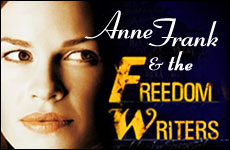 Identifying as a Jew
Identifying as a Jew


5 min read
The message of hope lives on in a most unlikely place.
When The Diary of Anne Frank was first made public almost 50 years ago, she came to signify the tragic heroes who survived the Holocaust, although she was certainly more heroine than tragic. Here was a young Jewish girl, hiding from the Gestapo with her family in a secret apartment in Amsterdam looking at an uncertain survival. Yet her diary revealed a sense of optimism for a better future, a lack of fear, and hopefulness that against all odds they would survive. And though Anne Frank perished, the diary that she left behind lives on, and continues to powerfully impact the lives of others.
The movie "Freedom Writers" is based on the true story of Erin Gruwell, played by Academy Award winner Hilary Swank. Erin is a novice high school teacher whose first assignment is teaching freshman English to a class of angry and disinterested white, black, Latino and Asian students in Long Beach, California after the Rodney King riots in 1992. Passionate about teaching and determined to make a difference, she isn't easily deterred by her students' angry outbursts and a general lack of interest in learning anything she's so earnestly trying to teach them. Instead, she searches for ways to appeal to them.
The opportunity presents itself in the form of a cartoon she confiscates from one of the students in class. Depicted in the cartoon is a hand drawn caricature of a black man with exaggerated thick lips. Erin then makes the connection between the drawing she holds in her hand and the cartoons used for anti-semitic propaganda leading up to the Holocaust - which only one student in the class had even heard of. But now that she has their attention, the door to their expanded universe is about to open.
Since the school board and her superiors consider her students a lost cause, Erin takes two part time jobs so that she can buy her students books that they can relate to. Surprisingly, instead of choosing a book about the inner city experience, she selects one with a Jewish theme instead -- The Diary of Anne Frank. Unexpectedly, it is a book to which they feel an instant connection. Not only can they understand Anne's adolescent angst, but they also know well her feelings of helplessness and alienation in a world she cannot control but which threatens to destroy her. With drive by shootings, random attacks and gang wars a normal part of their own lives, they see the destructive power of prejudice and blind hatred.
"Anne Frank understands our situation," says Eva, one of the Latina girls. So totally identified is she with Anne that when she realizes that Anne dies, Eva is outraged and feels personally betrayed. "Why didn't you tell us that she dies?" she rails at Erin.
The Diary serves as a moral imperative to rise above their own suffering and to survive, enlightened just as the Jewish people have managed to do.
Erin then gives them journals in which to make daily entries on anything at all that comes to mind. Their personal writings convey the tension, mindless violence, and sadness that dominate their lives. Excerpts from their journals are used very effectively in voice-overs during the film and their prose eventually becomes The Freedom Writers' Diary, an anthology on which the film is based.
When the students learn that Miep Gies, the Dutch woman who risked her life to keep the Frank family hidden, is still alive in the Netherlands, they embark on a fund raiser to bring her to their class as a guest speaker. It is the emotional highlight of the film. Visibly moved by the courageous stories of this now elderly woman (played by actress Pat Carroll), the students instantly see her as a hero.
"I was not a hero," she says. "I was an ordinary person. All I did was do the right thing. But you are heroes everyday. You are turning on a light in a dark room."
Seeing that her young charges are now committed to "The Diary," Erin herself sponsors a trip to the Simon Wiesenthal Center Museum of Tolerance in Los Angeles. To personalize the experience, each student is given a card with the picture and story of a child who perished in the Holocaust. It is a poignant, wordless moment in the film, appropriately followed by a dinner with four Holocaust survivors.
This little gem of a film is filled with fine, authentic, credible performances, especially Hilary Swank's which is powerful without being dominating. It also does not use the suffering of the Jewish people to exploit sentimentality. Instead, it provides a context in which these young people can see their own suffering, not as a justification to keep them in the misery of their own lives, but rather as a moral imperative to rise above it and to survive, enlightened just as the Jewish people have managed to do. It's an extraordinary example of learning the lessons of history for personal transformation and renewal.
It is no accident that the majority of Erin Grewall's students went on to college. Their creating The Freedom Writers' Diary serves as a testimony to their transformation. As one of the students says in reference to their diary, "It's something to leave behind. We were here. We mattered." Just like Anne Frank.
